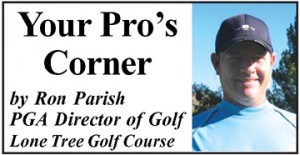Golf Column: Use the ground for leverage
Thursday, March 7th, 2013By Ron Parish, PGA Director of Golf, Lone Tree Golf Course
I passed on a quote I heard from the great instructor Jim Flick at a training seminar in last months article, “Golf demands you learn the game on it’s timeline”, well worth reflecting on if you seem to be practicing hard and not having much in return. Remember, trial and error are part of the game and part of learning.
Tributes to Mr. Flick continue this month and one thing he would strongly emphasize in his teaching was “Use the ground for leverage”. I find this focus is very worthwhile for many reasons but in particular, I think the average golfer benefits more from this emphasis then some of the mainstream current Tour Pro concepts.
For starters, realize that this is an idea that the great Jack Nicklaus embraced (Mr. Flick worked with Jack regularly) and used in his own game to be one of the most powerful hitters in his day and of all time. What does this mean, use the ground for leverage? Well for starters, where are the biggest muscles in your body? They are in your legs and “tuck-us”. So if we are going to get power effortlessly doesn’t it make sense to use these muscles and not just the hands, arms, and upper torso? Especially for your average Joe who can’t get to the gym everyday. To understand using the ground for leverage, here are some other sports’ motions where the legs are used that are worthwhile comparing to and can help shed understanding for how this power can be created:
-
A field goal kicker using his “plant” leg
-
A baseball pitcher shifting off the mound
-
Snow skier shifting into the next turn.
-
Hockey player shifting or stopping on the edge of their skate
-
A hip throw in judo
All of the above utilize the body’s weight shifting with the strength and leverage that the legs and lower body can balance, store, and transfer. And when it transfers, it is amazing what power can be generated no matter what your size (fyi: Jack Nicklaus isn’t that tall or big). So above are some analogies, now some drills for you to try and go out and see if you can discover and dial into this concept:
-
1/2 and 3/4 wedges with leg work. It’s like learning to dance. Got to start slow and small before you get going to fast. Hit half a bucket of balls and vary the distance on your wedges, only hitting anywhere from 40% to 80% your full wedge distance. Vary the distance on every shot. I recommend a sand wedge. As you do this. Just listen to your legs and how the weight shifts back and forth. If you do it right, you will find that the rest of your body (the torso turn, the arms and hands swinging) will synchronize with your legs. Hit it a little fat or thin? Out of synch I will bet you. As you continue with this, keep the grip pressure light and really try and power the shot with the shift of your weight. I bet you will learn something.
-
Step drill. Tee up a ball with a 7 iron. Set up to the ball with a normal stance but before swinging, bring the front foot all the way back to the back foot so that you are standing with feet together. Keep the knees flexed. Then start the swing back. Going forward, to hit the ball you are going to have to “step” off the back foot to get to the ball. You will really learn about the role of the back leg and foot here. Also a lot about timing. If the ball goes let of your intended line, you will have started the forward swing with your upper body. If your ball goes right of your intended line (not many do this) the lower body will have pushed to hard to start the forward swing or have started too soon. However, You are going to have to “step” forward before you completer your backswing. Play with this. Step earlier one time then the other. You will learn a lot. Allow your hands to have some hinge while you step forward. This is called loading or lagging and Guys like Sergio Garcia and Greg Norman used this to generate power. Great drill, but only do it for a portion of your bucket. I’ve found if it gets over practiced you can develop too much of a lateral motion.
-
“Heal lift” on the driver drill. Ok this one is fun. To use the ground for leverage, the weight has to coil and shift to the back leg during the swing. I think this drill really teaches that. Take the driver and set up to a teed up ball as normal. Before taking the club back, lift up the heal of the front/target foot. As soon as the heel is up (the weight will naturally shift back to your back foot) start the swing and go ahead and hit the ball. What you are going to notice is that you “really” get into your back leg this way. And if you get into it on the backswing, you are going to be able to shift off of it for the forward swing and understand what it is to use the ground for leverage.
Hey, you are going to have some swings on drill #2 and #3 that get out of synch, so don’t beat yourself up if you send one or two off line or thin/fat. That is all part of the learning. But if you pay attention, you are going to figure out what it means to use the ground for leverage and how to generate power from this concept. One last point, the key is to synchronize it. What’s that mean? Everything is in balance and working together. You will start to notice this more and more. One thing I think helps is to keep in mind that when Jack was asked what he wanted to do to hit one really big, he would always say, “I would take more time to swing”. Notice he didn’t say he would swing faster or harder, he just took more time to complete his swing and use his powerful legs
Thank you for all you do for Golf and for Lone Tree Golf Course and Event Center. Please help grow the game and invite someone new to join you in 2013! The game needs you ……and them.
Your Pro,
Ron Parish, PGA
If you are interested in reviewing other articles from Coach Ron go to www.lonetreegolfcourse.com under “The Course” tab.






























